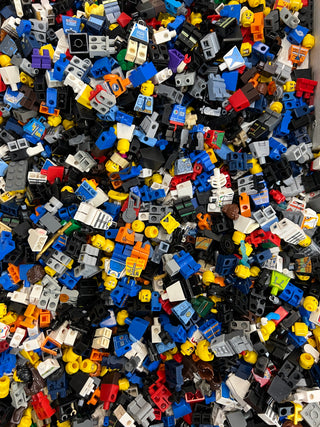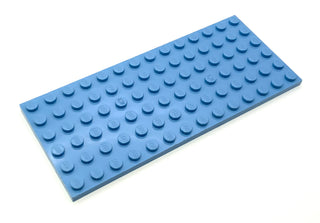Question: How do you check the condition of or grade a Lego Minifigure.
Answer:
We check the condition of hundreds of LEGO® Minifigures everyday. We currently sell LEGO® Minifigures in good, collector's quality condition (This means free of any play wear such as visible scratches, cracks, nicks, or bite marks) and in slightly used, and used conditions. Some things we may overlook when determining if a LEGO® Minifigure is in good, collector's quality condition are few micro-scratches. Micro-scratches are very small scratches that cannot be seen from all angles, you have to angle the plastic surface just right in order to see the tiny scratch. These tiny scratches are almost always found on brand new LEGO® Minifigures straight out of a factory fresh set because LEGO® does not package the minifigure separate from other LEGO® pieces and the scratches occur as the set moves around and the pieces bang against each other. However, some minifigures get heavy micro-scratches when played with so if there are a lot of micro-scratches, it is not considered good condition. See pic below for acceptable and not acceptable micro-scratches.
We get LEGO® Minifigures from everyway you can imagine; brand new from sets, brand new or used from customers trading or selling us them, brand new or used from large collections, etc. We receive hundreds of LEGO® Minifigures per day and throughout the condition checking and inventory process we handle the minifigure at least 7 times and by multiple employees. Each time we handle a LEGO® minifigure we double check it for condition issues. There is so many different and odd things that can be wrong with a LEGO® Minifigure that even the best of us may miss something.
The first thing we do when receiving a LEGO® Minifigure is to make sure their parts are correct. We can look at most LEGO® Minifigure parts and tell what minifigure they are from. This is because we handle hundreds every single day for the past 10+ years and we have become experts. According to Bricklink, there are currently 14,221 unique LEGO® Minifigures, all with different part combinations. Certain LEGO® parts have different molds as well; for example there are at least 3 versions of the classic smiling LEGO® Minifigure yellow head, one with an open blocked stud, one with and open stud with breathe hole, and one with a closed stud on top. So it can be very challenging confirming your LEGO® minifigure has all the correct parts. 
After confirming the LEGO® Minifigure has all of its correct parts, we quickly glance at it to see if there are any obvious flaws, if there are, it gets put aside and considered a "played with" minifigure, not worthy for sale as a good condition, collectible.
If it looks good at first glance, we then check the next easiest thing which is looking at the minifigure torso, back and front, and turning it slightly in the light to see if there are any smaller, harder to see flaws. It is very important to have good light, not only for identifying hard to see or find flaws but also for checking to make sure the minifigures colors have not changed. Certain LEGO® colors such as white are notorious for turning a yellow or tan color that cannot be seen in low light conditions.
After checking for smaller surface flaws on the torso, we move the arms to make sure they are as tight as they are supposed to be and also check under the arms on the torso because this is one of the first places for a LEGO® Minifigure to crack. Minifigure torsos crack under the arms because of the extreme clutch power from the legs putting pressure on it, forcing it to crack over time.
 It is a good idea not to store your LEGO® Minifigures with the torso fully assembled on the legs. The torso can crack while in a collectors case if fully assembled. Certain LEGO® colors are more prone to cracking than others and also certain production years of the plastic are more prone to cracking than others. Another place that may naturally crack over time is on the back of the torso where the legs are coming into the torso and on the back of the arms where the hands are entering the arms.
It is a good idea not to store your LEGO® Minifigures with the torso fully assembled on the legs. The torso can crack while in a collectors case if fully assembled. Certain LEGO® colors are more prone to cracking than others and also certain production years of the plastic are more prone to cracking than others. Another place that may naturally crack over time is on the back of the torso where the legs are coming into the torso and on the back of the arms where the hands are entering the arms. 

Confirm the arms are free of scuffs, nicks or bite marks. Check the condition of the hands while you are looking at the arms. It is rare but sometimes we have found the supports inside the LEGO® Minifigure torso are broken or stressed so we do have to check inside the torso as well. It is also important to remove the head and confirm the neck is in good condition. One condition issue often found on brand new minifigure torsos is that down at the bottom, usually on the front, there may be a nick or scuff from where it came off of the mold. This is common to find on brand new minifigure torsos right out of the package so this may be an acceptable condition flaw for some buyers. We do not note it on most minifigures unless they are exclusives and in the hundreds of dollars plus range.
After confirming the torso is in good condition, we check the legs as they are often the same color and our eyes are adjusted to that color. LEGO® minifigures feet and the stud holes behind their legs can crack, nick or get stress marks from being stuck to LEGO® studs so make sure they are in good condition. Just like the torso, you have to move the legs at different angles in the light to see if you see any flaws. You also need to move the legs forward and backward to see hidden flaws and confirm they are as tight as they should be. Loose legs are not considered good condition.
After confirming the legs are in good condition, we check the head. The head needs to be moved at different angles under the light to see the flaws. It should be free of any visible flaws. The only flaws that might be natural are printing flaws. We do see more printing flaws on curved LEGO® pieces such as heads. Another common factory flaw is a small vertical line in the LEGO® head. It is not a crack but almost looks like a seem. Some LEGO® head molds have horizontal seems around the top of the head as well. Be sure to check the top of the head stud rim, bottom of the head hole/neck rim and inside the head as well. Certain color LEGO® heads are prone to cracking from how tight they fit on the torso neck. This is most common in the glow-in-the-dark head found on the classic Harry Potter Severus Snape minifigure. It starts with a stress line fracture and will eventually crack. This is not considered collectors quality.
Most headgear and hair pieces are found in better condition than the other minifigure parts, however, it is important to inspect them from all angles as well. A common problem we see on certain fragile headgears such as Qui Gon Jinn's mullet hairpiece, are stress fractures on the fragile side burns that it has. This ruins any collector's value of the hairpiece.
Rubber molded heads and headgear can become damaged very easy. The most common problems are the printing rubbing off of the rubber and the stud connection getting too loose or rubber looking too worn. The Clone Wars Yoda has printed white or gray hair on the back of the head, this is quite often rubbed off at the tips and can no longer be considered good condition. 
On minifigures with sandwich torso/heads such as Chewbacca and spongebob, be careful removing the sandwich part because we naturally want to grip the belly and back and once it is removed from the torso, there is nothing preventing the belly and back from being pressed together too hard and breaking.
As mentioned earlier, LEGO® Minifigures can crack, fracture, get stress marks or turn color while in storage or being displayed. For this reason we do not suggest having LEGO® Minifigures professionally graded. While storing or displaying them, you may want to not fully connect the parts of your expensive LEGO® Minifigures.
Once we have determined a LEGO® Minifigure is in good collectors quality condition, we put it in a drawer according to its theme to be processed by employee who is assigned to manage that theme. The theme manager puts the minifigure online for sale and stores it in the proper theme sorted drawer or restocks the cases in our storefront. We also handle the minifigure again when we sell the minifigure. At all stages of the process we double-check the condition of our LEGO® Minifigures.
Lets recount the steps and opportunities to check the condition of LEGO® Minifigures:
1) When we receive/purchase the minifigure
2) When we put the Minifigure on our minifigure receiving table
3) Condition checking from the receiving table and sorting by theme
4) Processing all the minifigures in that theme by putting them online
5) Putting the minifigures away in storage or display
6) When we go to get the minifigure for an order.
7) When we hand over the minifigure to the customer or ship it.
Thank you for reading and if you have any suggestions or think we may have overlooked something let us know!





